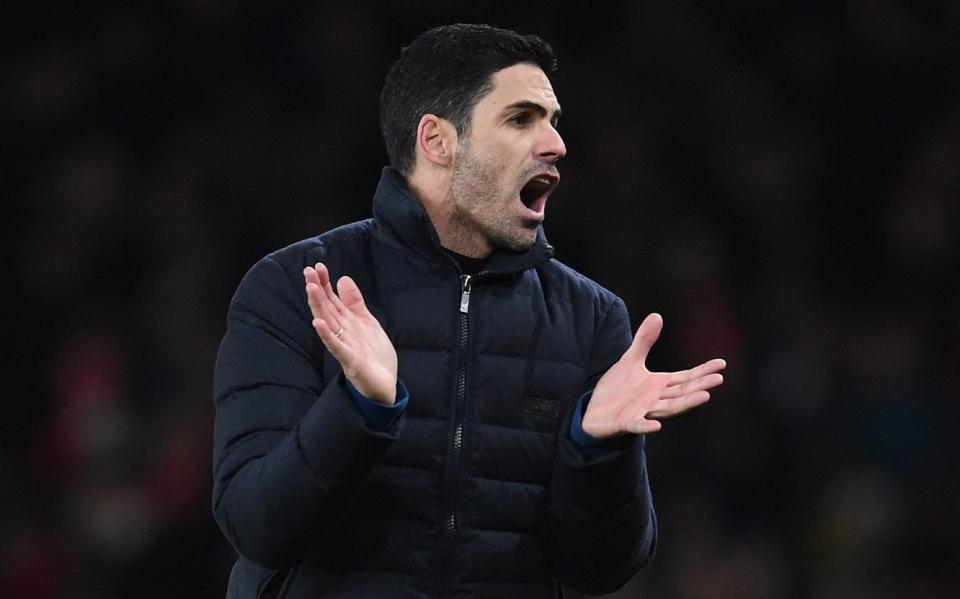Why Arsenal's red cards are a black mark against Mikel Arteta's management

They would have been joyfully punching the air in the corridors of Arsenal’s London Colney training base when Ghana were knocked out of the Africa Cup of Nations on Tuesday. Ghana’s shock defeat to lowly Comoros had provided Mikel Arteta with an unexpected and timely boost: Thomas Partey was coming home, and he would be back in time for the league game against Burnley on Sunday.
Of all the players to rush back into the team, in all the positions, Partey would have been number one on Arteta’s list. Arsenal are desperately short of central midfielders and, without the suspended Granit Xhaka, it would have been a considerable relief for the Arsenal manager that one of his key players had suddenly become available.
Partey touched down in London at around midday on Thursday. At which point, everything went wrong. Thrown into the action against Liverpool in their League Cup semi-final a few hours later, Partey swiftly became the latest Arsenal player to receive a red card under Arteta’s management. Just as Arsenal looked to be emerging from their dramatic personnel problem (which led to the north London derby being postponed) Partey’s dismissal rolled them back down the hill.
“I should be more intelligent not to get in a challenge already booked but this is my personality,” said Partey in a social media post on Friday morning. “I like to fight for every ball.”
Arsenal now face Burnley on Sunday without both Partey and Xhaka, who are fit and Covid-free but suspended from action. It is a worryingly frequent problem for Arteta, who has seen his team pick up more red cards in 2022 (three) than they have scored goals (one).

“We have played the last three games with ten men and against top sides you can't do that because we are completely exposed,” said the Arsenal manager. “We have to eradicate that completely. We want to be competitive, we want to be winning matches and having a good sequence of matches again, and we have to stay with 11 players.”
Since the Spaniard’s first match in charge of Arsenal, on Boxing Day in 2019, Arsenal have received 14 red cards in all competitions. By way of comparison, no other Premier League club has been shown more than eight in that time. This is not just the occasional disciplinary issue, but a long-running and deeply concerning pattern.
The obvious question to ask, then, is why it keeps happening. “For different reasons,” was Arteta’s assessment, and it would certainly be unfair to put all 14 red cards into one bracket. Some of them have been the result of plain stupidity, for example when Granit Xhaka inexplicably grabbed the throat of Burnley’s Ashley Westwood last season.
There must be, though, a tactical or systematic reason for Arsenal’s dreadful disciplinary record. The most obvious potential explanation is the defensive structure that Arteta demands. The dismissals of Xhaka against Liverpool last week (a straight red card for a last-ditch lunge on Diogo Jota) and Gabriel Magalhaes against Manchester City on New Year’s Day were both the result of opposition attackers exposing Arsenal’s high defensive line.
Arteta wants his players to push up the pitch, to squeeze the opponent in their own half. The danger of this is that, when they are turned, there is plenty of space for attackers to run into. One mistimed foul, one desperate attempt to shut down a counter-attack, inevitably results in disciplinary action. The red card shown to David Luiz against Wolves last season was a fine example of this: Willian Jose had darted into the open space behind the Arsenal defence.
Other teams, notably Manchester City and Liverpool, also deploy a bold high line. The simple reality here is that these teams are better at it than Arsenal. It should be noted that Southampton (eight red cards), Brighton (seven) and City (seven) are the clubs with the most red cards after Arsenal over the past two years. All of them operate with a high line, pressing the opponent across the pitch.
Another potential factor is the intensity and aggression that Arteta asks for at all times. Just as he hurtles around his technical area during matches, kicking every ball and co-ordinating every move, he wants his players to play at full-speed, full-time. Press with menace, get in the faces of the opposition, win the ball back in the opposition half.

A consequence of this is occasional over-eagerness, or indeed over-aggression, and Arsenal’s players have regularly lunged into wild challenges during Arteta’s tenure. Even the strikers have been guilty of this: Pierre-Emerick Aubamyenag was dismissed for a mistimed lunge on Crystal Palace’s Max Meyer in January 2020, and Eddie Nketiah saw red for a wild tackle against Leicester City in July that year.
Arteta will not compromise on his tactical principles, and he will evidently not suddenly ditch the high line in a bid to avoid further red cards. But it is clear that something must change, whether it is the execution of the game-plan or the mentality of the players. For too long this has been too much of a problem, and at this rate it could cost Arsenal a place in the top four.

 Yahoo Sport
Yahoo Sport 





































